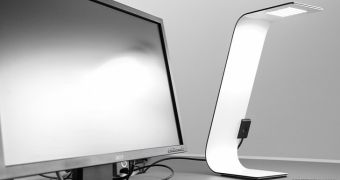If you were to drop by the website of Germany-based FSIGN lighting solution provider, you might stumble upon the oneLED table luminaire. As it happens, this lamp is a lot more unusual than it seems.
And that's saying a lot, considering the pretty minimalistic, simple design and the LED array that produces the light.
Although it's not just the LED array that should be taken into account here. If it had been used alone, oneLED would not have cast as wide and bright a light as it does.
The secret of the lamp lies in the 6 x 6 convex lens array. The LUXeXcel 3D Printed Lens Array to be specific.
Normally, to even bother producing such small lenses would need a large batch of orders at minimum, since glass isn't exactly the cheapest thing to shape to specifications.
3D printing technology, however, allows even small order to be filled inexpensively. The lenses used by the FSIGN oneLED table luminaire (French word for desk lamp) uses the lenses to turn a wide 120° beam angle to a 60° angle.
This means that it's better for small offices and shared bedrooms, because it only lights up specific areas, where you're working on a file or whatever else.
The little depth of the lamp and the small distance between the LED chip and the lens was limited, which posed a challenge.
It's why a lens array was used instead of a larger light bulb head, with 36 individual lens bulbs set on a flexible substrate plastic only 500 microns thin. All in all, the oneLED is just 4mm thin.
LUXeXcel CEO, Richard Van de Vrie, employed the Inventor software from Autodesk and went through some virtual trial and error before the final product was decided upon.
Curiously, though, the printer used to create the lenses wasn't a standard 3D printer, but a wide format industrial ink-jet printer that jetted transparent droplets of a polymer that could be cured with ultraviolet light. The resolution was of 1440 dpi, or thereabouts. No mold or finishing was required, ultimately allowing the process to be quick and straightforward.
Maybe in the future, we'll come upon some method that will 3D print everything, from the lamp stand to the LEDs themselves. Eventually, 3D printing technology will be streamlined enough to do all that at the same time. For now, though, it's only parts of consumer and enterprise products that can be created through additive manufacturing.

 14 DAY TRIAL //
14 DAY TRIAL //